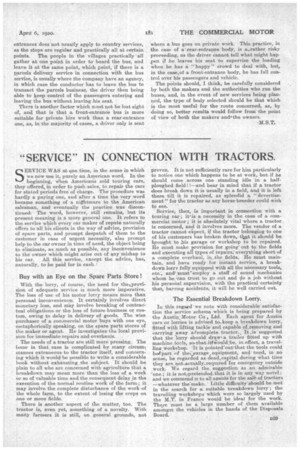ENTRANCES FOR MOTORBUSES.
Page 14

Page 15

If you've noticed an error in this article please click here to report it so we can fix it.
The Divergent Reasons for Employing Front and Rear Entrances.
IN THE EDITORIAL columns of The Commercial Motor a few weeks ago, I noticed a brief article on straphanging, specially applied to the doubledeck buses in London. This question of extra load is not confined to London only ; in fact, it' is more serious in the provinces, there being no limit in some districts as to the number of passengers to be carried on a bus, I myself having seen a bus started on a 20mile journey with, 16 passengers over the seating accominodatiOn (34).
This traffic is, I admit, very difficult to organize and control, as one cannot always judge the traffic on long-distance runs, yet, at the same time, I must say that I fail to see how some of these provincial companies would, pay their way if it were. not for the extra passengers catried during certain days of the week, filich as market days, etc.
In a large flambe/ of cases, it is only with the heavy loading in the summer that some of the companies are able to show a profit at the end of the year. The receipts during the winter months are often very low, and a large amount of dead mileage has to be run, as, for instance, an undertaking haying its centre in a country town, with sonaoof the services running out fora distance of twenty mike. These buses nick up very few passengers on the first out ward journeys 9,d' the, last inward journeys during the Winter months the result being that the companies are compelled to close their eyes to overcrowding, to a certain extent, if there is an opportunity of carrying extra passengers—which brings me to the point of my argument, front versus rear entrances for long country journeys.
The tendency for passengers in an over-crowded bus is to keep as near the door as possible ansl, unless the conductor is exceptionally efficient it packing his bus, practically all the extra weight is concentrated near the door, which means, in the ease of a rear entrance body, that the extra weight is behind the rear axle the rearsprings being compressed and strained as the weight behind is compounded through the cantilever action of the chassis frame every time the rear wheels drop into a rut ill the road. In fact, I have known the.-chassis side frame to crack close to the front body holding-down bolts. The crack baying started at the top of the frame convinced me that overweight at the rear, combined with the bad roads, was the cause of the fractures, as both sides of the frame had started and we could not find,any flaw in the metal.
This, iirmy opinion, would not have happened if the body had been of the front-entrance type, as the passengers having the same tendency to keep near the door, the extra weight is more equally distributed over the whole chassis: An overload at the rear also puts a big strain on the engine if the route, is a hilly one.
Of course, I will admit-that there are sound arguments for both types of bodies and, in my opinion,' both have their uses. For short-distance traffic, such as town work, the rear entrance is the type that I should advocate, as the entrance can be made more convenient, there being more scope for that at the rear of the body. The steps can also be made easier for elderly people, which means a great saving on short runs and makes for quick service. It is also more suitable for men jumping on and off, which saves a large amount of stopping in a day's running. In the event of an overload, it is usually near the middle of the journey, where the roads are the best, that the heaviest traffic is carried, and then it is only for a short distance before some of the passengers alight.
The front-entrance body, however, is, in my opinion, the ideal type for longdistance runs, as, in the case of an overload the weight is carried for longer distances and the bus has less favourable road conditions to contend 'with, whilst the arguments put forward for 'ftime-saving with rear entrances does not usually apply to 'country services, as the stops are regular and practically all at certain points. The people in the villages practically all gather at one point in order to board the bus, and leave it at the same point, which point, if there is a parcels delivery service in connection with the bus service, is usually where the company have an agency, in which case the conductor has to leave the bus to transact the parcels business, the driver then being able to keep control of the passengers entering and leaving the bus without leaving his seat.
There is another factor which must not be lost eight of, and that is that a front-entrance bus is more suitable for private hire work than a rear-entrance one, as, in the majority of cases,, a driver only is sent where a bus goes on private work. This practice, in the case of a' rear-entrance body, is a-rather risky proceeding, as the driver cannot tell what might happen if he leaves his seat to supervise the loading When he has a " happy" crowd to deal with, but, in the case,of a front-entrance body, he has full control over his passengers and vehicle.
The points should, I think, be carefully considered by both the makers and the authorities who run the buses, and, in the event of new services being planned, the type of body selected should be that which is the most useful for the route concerned, as, by doing so, better results would follow from the point of view of both the makers and.the owners.




























